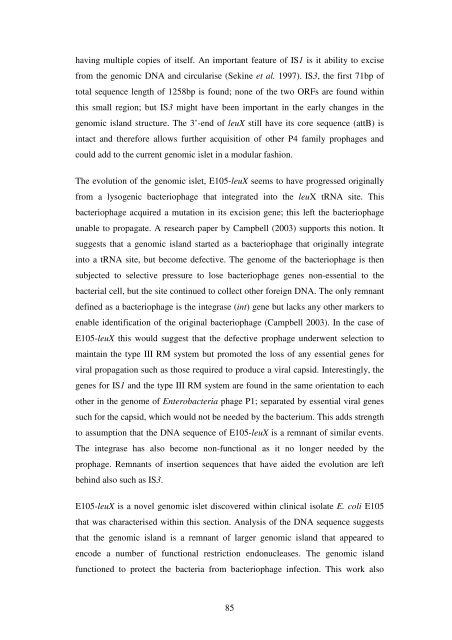5 The role of quorum-sensing in the virulence of Pseudomonas ...
5 The role of quorum-sensing in the virulence of Pseudomonas ...
5 The role of quorum-sensing in the virulence of Pseudomonas ...
You also want an ePaper? Increase the reach of your titles
YUMPU automatically turns print PDFs into web optimized ePapers that Google loves.
hav<strong>in</strong>g multiple copies <strong>of</strong> itself. An important feature <strong>of</strong> IS1 is it ability to excise<br />
from <strong>the</strong> genomic DNA and circularise (Sek<strong>in</strong>e et al. 1997). IS3, <strong>the</strong> first 71bp <strong>of</strong><br />
total sequence length <strong>of</strong> 1258bp is found; none <strong>of</strong> <strong>the</strong> two ORFs are found with<strong>in</strong><br />
this small region; but IS3 might have been important <strong>in</strong> <strong>the</strong> early changes <strong>in</strong> <strong>the</strong><br />
genomic island structure. <strong>The</strong> 3’-end <strong>of</strong> leuX still have its core sequence (attB) is<br />
<strong>in</strong>tact and <strong>the</strong>refore allows fur<strong>the</strong>r acquisition <strong>of</strong> o<strong>the</strong>r P4 family prophages and<br />
could add to <strong>the</strong> current genomic islet <strong>in</strong> a modular fashion.<br />
<strong>The</strong> evolution <strong>of</strong> <strong>the</strong> genomic islet, E105-leuX seems to have progressed orig<strong>in</strong>ally<br />
from a lysogenic bacteriophage that <strong>in</strong>tegrated <strong>in</strong>to <strong>the</strong> leuX tRNA site. This<br />
bacteriophage acquired a mutation <strong>in</strong> its excision gene; this left <strong>the</strong> bacteriophage<br />
unable to propagate. A research paper by Campbell (2003) supports this notion. It<br />
suggests that a genomic island started as a bacteriophage that orig<strong>in</strong>ally <strong>in</strong>tegrate<br />
<strong>in</strong>to a tRNA site, but become defective. <strong>The</strong> genome <strong>of</strong> <strong>the</strong> bacteriophage is <strong>the</strong>n<br />
subjected to selective pressure to lose bacteriophage genes non-essential to <strong>the</strong><br />
bacterial cell, but <strong>the</strong> site cont<strong>in</strong>ued to collect o<strong>the</strong>r foreign DNA. <strong>The</strong> only remnant<br />
def<strong>in</strong>ed as a bacteriophage is <strong>the</strong> <strong>in</strong>tegrase (<strong>in</strong>t) gene but lacks any o<strong>the</strong>r markers to<br />
enable identification <strong>of</strong> <strong>the</strong> orig<strong>in</strong>al bacteriophage (Campbell 2003). In <strong>the</strong> case <strong>of</strong><br />
E105-leuX this would suggest that <strong>the</strong> defective prophage underwent selection to<br />
ma<strong>in</strong>ta<strong>in</strong> <strong>the</strong> type III RM system but promoted <strong>the</strong> loss <strong>of</strong> any essential genes for<br />
viral propagation such as those required to produce a viral capsid. Interest<strong>in</strong>gly, <strong>the</strong><br />
genes for IS1 and <strong>the</strong> type III RM system are found <strong>in</strong> <strong>the</strong> same orientation to each<br />
o<strong>the</strong>r <strong>in</strong> <strong>the</strong> genome <strong>of</strong> Enterobacteria phage P1; separated by essential viral genes<br />
such for <strong>the</strong> capsid, which would not be needed by <strong>the</strong> bacterium. This adds strength<br />
to assumption that <strong>the</strong> DNA sequence <strong>of</strong> E105-leuX is a remnant <strong>of</strong> similar events.<br />
<strong>The</strong> <strong>in</strong>tegrase has also become non-functional as it no longer needed by <strong>the</strong><br />
prophage. Remnants <strong>of</strong> <strong>in</strong>sertion sequences that have aided <strong>the</strong> evolution are left<br />
beh<strong>in</strong>d also such as IS3.<br />
E105-leuX is a novel genomic islet discovered with<strong>in</strong> cl<strong>in</strong>ical isolate E. coli E105<br />
that was characterised with<strong>in</strong> this section. Analysis <strong>of</strong> <strong>the</strong> DNA sequence suggests<br />
that <strong>the</strong> genomic island is a remnant <strong>of</strong> larger genomic island that appeared to<br />
encode a number <strong>of</strong> functional restriction endonucleases. <strong>The</strong> genomic island<br />
functioned to protect <strong>the</strong> bacteria from bacteriophage <strong>in</strong>fection. This work also<br />
85














